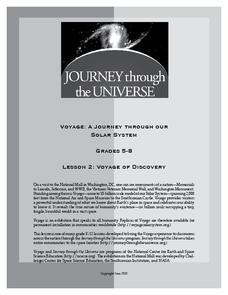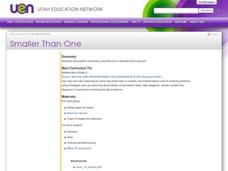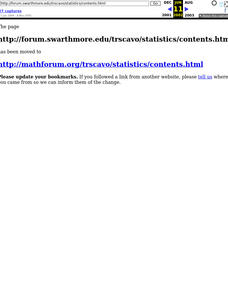Curated OER
Smaller Than One
Students examine how to convert fractions into decimals and percents. They work with base ten blocks and a worksheet to color in parts of 100 and renaming the parts as decimals and fractions.
Curated OER
Color Me Large or Small Worksheet
Before handing out this number-value worksheet make sure you explain all directions clearly, as they may throw some students for a loop! Using starting numbers in a table, they first shade in all boxes with numbers smaller than that...
Illustrative Mathematics
Converting Fractions of a Unit into a Smaller Unit
There is more than one way to answer a question; especially when you have fractions in measurement. Here are three questions with real-world situations in which 5th graders are asked to provide answers in three ways: a larger unit of...
Journey Through the Universe
Voyage of Discovery
Did you know that Pluto is smaller than the United States of America? It is difficult to conceptualize the size of planets and the distance between them, and the lesson addresses those exact issues. After a discussion, pupils create...
Curated OER
Smaller Than One
Sixth graders practice converting a fraction into a decimal and a percent. They explain relationships among rational numbers. They order and compare whole numbers, fractions (including mixed numbers), and decimals using a variety of...
Curated OER
Comparing
Practice the comparison words lighter, heavier, longer, shorter, smaller, and bigger using this visual chart. For each set of three objects, pupils order them according to one of these terms. The six terms are illustrated above for...
Cornell University
Thinking with the Eyes
Objects are larger (or smaller) than they appear! Scholars use a laboratory investigation to explore the difference between resolution and magnification. The activity allows them to calculate the size of the field of view of their light...
Curated OER
Adventures in Statistics
Here is a fantastic lesson for your fifth grade math scholars. In it, learners must determine if the classrooms of upper graders are bigger, or smaller, than the classrooms of the lower grades. Some excellent worksheets are embedded in...
Scholastic
Study Jams! Atoms: Protons, Neutrons, Electrons
What's smaller than a kiwi seed? Atoms! Basic atomic structure is detailed for beginning chemists in a light-hearted animation. Protons and neutrons are explained as part of the nucleus, and so are electrons that encircle the nucleus....
Royal Society of Chemistry
Units of Volume
Did you know in the UK a quart is smaller than in America? This explains why a standard unit of measure is necessary for volume. Young scientists learn the similarities and differences between five different units used to measure volume....
101 Questions
Thanksgiving Taters
What would a meal be without the taters? The question is, how long does it take to peel those potatoes? Given the rate of peeling one potato, scholars predict the time it takes to peel the bag. The twist is that the first potato was...
Curated OER
Comparing Numbers Up to 10 Step-by-Step Lesson
A teacher resource, this scripted lesson details how to explain to learners the steps involved in determining which numbers in a series are bigger or smaller than a given number. The referenced pupil learning exercise is not included.
Curated OER
Statistics
Seventh and eighth graders solve and complete three various types of problems. First, they find the median rate using the box-and-whisker plot shown. Then, learners describe the inter-quartile range. In addition, they determine whether...
Curated OER
Perspective Drawing for Beginners
Students explore perspective while drawing. In this perspective lesson, students discover that faraway objects should be drawn smaller than objects that are closer. Students experiment with perspective as they draw pictures of trees on a...
Colorado State University
Can You See Beyond the Rainbow?
There's more to light than ROYGBIV! An enlightening laboratory investigation has learners explore the world of infrared light. When they use goggles that take away visible light, they experience how things look with only infrared light.
Scholastic
Study Jams! Elapsed Time
Identify the larger number, place the smaller number on the bottom, and then subtract in order to determine elapsed time. Animated slides of each step are also narrated by a friendly voice to teach elementary math minds how to solve such...
Columbus City Schools
To Measure its Mass or Volume?
Atoms, elements, and molecules, oh my! Teaching the fundamentals of chemistry to curious sixth graders has never been easier to accomplish. Here is a resource that pulls together everything needed to get them off to a good start,...
Curated OER
Exponential Growth versus Linear Growth II
Your algebra learners discover that exponential functions, with a base larger than one, outgrow linear functions when the inputs increase sufficiently. Their analysis includes using a graphing calculator to produce tables.
Peace Corps
Brief Encounters
How are Pandyas different than Chispas? Explore cultural norms and societal behaviors with an engaging role-play activity. Split into groups of two hypothetical cultural groups, the formal Pandyas and the sociable Chispas, and another...
Curated OER
Properties of Materials
Students describe how objects in the universe range from smaller than atoms to larger than galaxies. they explain how the metric system works and compare it to the English system of measurement.
Scholastic
Study Jams! Customary Units of Length
See if your mathematicians can go from miles to yards to feet and back again with unit conversions. This video introduces the topic of the customary units of length and common equivalents. The main rule is to multiply when making...
Curated OER
Direct & Indirect Object Pronouns
There is a wealth of information provided here about direct and indirect object pronouns. Consider breaking these complex grammatical concepts into smaller chunks so that your Spanish language learners do not become overwhelmed. The At a...
CK-12 Foundation
Bowling Alley
Sometimes it appears that a bowling ball slides down the alley rather than rolling, while other times it appears to switch rolling directions at some point. Scholars control the bowling ball size, initial rotation, initial speed, and...
Curated OER
Larger or Smaller
In this number comparison worksheet, students determine how many time larger or smaller a number is than another number. There are 22 questions on this worksheet, and the answers are on the second page.























